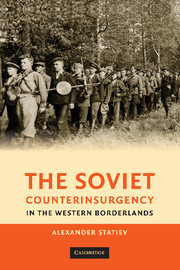Book contents
- Frontmatter
- Contents
- List of Figures
- List of Tables
- Acknowledgments
- Glossary
- Introduction
- 1 Origins of Soviet Counterinsurgency
- 2 The Borderland Societies in the Interwar Period: The First Soviet Occupation and the Emergence of Nationalist Resistance
- 3 The Borderlands under German Occupation (1941–1944): Social Context of the Soviet Reconquest
- 4 Nationalist Resistance after the Soviet Reconquest
- 5 Soviet Agrarian Policy as a Pacification Tool
- 6 Deportations, “Repatriations,” and Other Types of Forced Migration as Aspects of Security Policy
- 7 Amnesties
- 8 Red Rurales: The Destruction Battalions
- 9 Police Tactics: Actions of NKVD Security Units, Intelligence Gathering, Covert Operations, and Intimidation
- 10 The Church in Soviet Security Policy
- 11 Violations of Official Policy and Their Impact on Pacification
- 12 Conclusion: Nationalist Resistance and Soviet Counterinsurgency in the Global Context
- Appendix A Note on Used Terms and Geographic and Personal Names
- Appendix B Note on Primary Sources
- Bibliography
- Index
10 - The Church in Soviet Security Policy
Published online by Cambridge University Press: 05 May 2010
- Frontmatter
- Contents
- List of Figures
- List of Tables
- Acknowledgments
- Glossary
- Introduction
- 1 Origins of Soviet Counterinsurgency
- 2 The Borderland Societies in the Interwar Period: The First Soviet Occupation and the Emergence of Nationalist Resistance
- 3 The Borderlands under German Occupation (1941–1944): Social Context of the Soviet Reconquest
- 4 Nationalist Resistance after the Soviet Reconquest
- 5 Soviet Agrarian Policy as a Pacification Tool
- 6 Deportations, “Repatriations,” and Other Types of Forced Migration as Aspects of Security Policy
- 7 Amnesties
- 8 Red Rurales: The Destruction Battalions
- 9 Police Tactics: Actions of NKVD Security Units, Intelligence Gathering, Covert Operations, and Intimidation
- 10 The Church in Soviet Security Policy
- 11 Violations of Official Policy and Their Impact on Pacification
- 12 Conclusion: Nationalist Resistance and Soviet Counterinsurgency in the Global Context
- Appendix A Note on Used Terms and Geographic and Personal Names
- Appendix B Note on Primary Sources
- Bibliography
- Index
Summary
A small-town priest comes to the party secretary and asks him to lend a few chairs for the Easter service. The secretary is in a bad mood and refuses. This dialogue follows:
priest: “If so, you won't get seminary students for volunteer labor on Lenin's birthday.”
secretary: “Well, then I won't send Komsomol members to sing in the church choir.”
priest: “Then you'll get neither church wine for your party meetings, nor nuns to entertain you afterward.”
secretary: “This is really outrageous! You'll be expelled from the Communist party!”
– A Soviet jokeWhile invariably oppressive toward religion after 1917 and throughout the interwar period, the Soviet government made a dramatic shift of policy in 1943 when Stalin opted for a “concordat” with the Russian Orthodox Church. This act led to a frenzied rapprochement between the state and the Orthodox Church and some other denominations in the lands under Soviet control. Only then did the Soviet state make a consistent effort to employ the clergy for the war effort and later for pacification of the borderlands. Religion was a minor factor in the war between the pro- and anti-Soviet forces in the old territories because the younger generation, the primary source of manpower in the Red Army and partisan and antipartisan collaborator forces, was largely atheist. Religious sentiments were far stronger in the borderlands, although their impact on the decision to choose sides is difficult to measure.
- Type
- Chapter
- Information
- The Soviet Counterinsurgency in the Western Borderlands , pp. 253 - 271Publisher: Cambridge University PressPrint publication year: 2010



